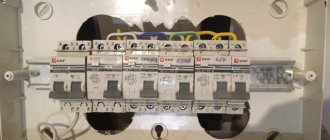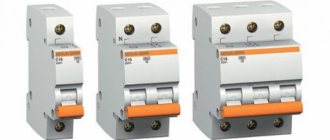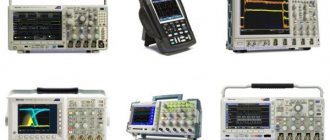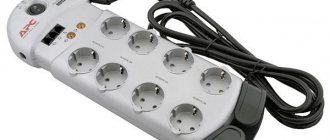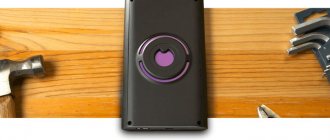| Place | Name | Characteristics in the rating |
| The best test detectors for hidden wiring |
| 1 | Mastech MS8902B | Best quality |
| 2 | Phase GK51 | The simplest device |
| 3 | STAYER Master Topelectro | Deep Scan |
| 4 | LA-1013 CEM-Instruments | Professional instrument with amplifier |
| 5 | NWS 819-4 | Widest range of detectable currents |
| The best hidden wiring detectors with positioning |
| 1 | Bosch GMS 120 Professional | The best choice |
| 2 | Mastech MS6818 | Maximum information content |
| 3 | Multi Stud Finder | A simple device without unnecessary options |
| 4 | ADA instruments Wall Scanner 80 | The best detector with tree detection capability |
| 5 | Practice Expert DU-100 M | Informative display |
A hidden wiring detector is a tool that can find wires and other elements in the wall. There are two types of detectors:
- testers, that is, reacting to the presence of a phase in the network at a distance;
- and pinpointers, that is, metal detectors that detect the presence of wires, regardless of whether there is voltage on them or not.
Detectors from the second category are, in fact, metal detectors, but with a limited range. They determine the location of metal elements and are also able to determine their type. Some tools can also detect wood. Unlike full-fledged metal detectors, detectors have a shallow search depth. Most often it is limited to five centimeters, but they are able to determine the location of the wire with an accuracy of a centimeter.
Test indicators have the same characteristics as regular indicators, the only difference being that they find the phase at depth. They cannot determine the location of the wire with accuracy, but they are much cheaper than pinpointers. Also, testers do not distinguish the type of metal, and if voltage is not applied to the wire, it will not be detected at all. When choosing a wiring detector, you should pay attention primarily to the search depth and positioning accuracy. But manufacturers often overestimate this parameter, and in order to find the truly best device at the most attractive price, you need to carefully study our rating, which includes the 10 most interesting options.
The best test detectors for hidden wiring
Tester detectors determine hidden wiring in the wall by the presence of a current phase in it. If the wire goes to ground, the indicator will not detect it, as in the case of no current. This tool is often used not to search for wires in the wall, but to determine the location of damage to the wiring. If current begins to be lost, the instrument signal will become weaker and disappear completely if there is no phase. Thanks to this device, you do not have to completely rip out the wiring from the wall to find the location of the damage.
What features of electrical wiring detectors should you pay attention to when choosing?
The choice of a hidden wiring detector is based on a study of its key technical parameters and features:
- The principle of operation of the device. The most common are electrostatic, electromagnetic and metal detector devices. They are suitable for solving most current repair and construction problems. More rare ultrasonic, capacitive and combined devices are able to detect foreign objects from any materials.
- Localizable materials. First of all, this is electrical wiring, as well as ferrous/non-ferrous metals, communication lines, live networks, wooden structures, plastic, voids. It should be noted that inexpensive models do not always confidently cope with material recognition.
- Detection depth. The value of this parameter depends on the materials from which the walls are made, the presence of reinforcement and voids. If possible, it is better to choose a device with a reserve detection depth from professional models.
- Automatic calibration. The option automatically adjusts the device’s sensors depending on specific operating conditions. Automatic calibration is performed when the detector is first started or the search mode is changed.
- Type of food. Hidden wiring detectors receive energy from AA, AAA, Krona batteries, or a rechargeable battery. On average, the device's continuous operation time is 5-6 hours. The parameter is influenced by many factors, so a spare set of batteries will never be superfluous.
- Display and indication. The presence of a display increases the usability of the device. All basic information is displayed on a small LCD screen. A number of devices are equipped or supplemented with sound and light indication.
The best hidden wiring detectors with positioning
It is not always the case that the wiring that needs to be found in the wall is live. A test indicator is not suitable in this case, and only a positioning tool will cope with the task, which not only finds metals in the wall, but distinguishes them from each other. With such a device it is impossible to confuse a nail and a cable; moreover, they often have a wood search function, which is very convenient if you need to find a block under the trim in order to hammer any fasteners into it. Such devices are more expensive than testers, but there are also quite budget models, albeit with limited functionality.
Compare the best devices!
See the characteristics of the nominees for the title of best detector.
| Model | Detection depth, cm | Material | Autonomy, hour | Price, rub | ||
| Black metal | Cable | Tree | ||||
| ADA instruments Wall Scanner 50 | 5 | 5 | – | black, non-ferrous metal | 8 | 800 |
| DIY duwi | 3 | 2,4 | – | ferrous, non-ferrous metals, wiring | 5 | 600 |
| ADA instruments Wall Scanner 80 | 8 | 5 | 2 | black, non-ferrous metal | 6 | 2500 |
| Bosch Truvo | 5 | 7 | – | black, non-ferrous metal, electrical wiring | 6 | 1200 |
| Mastech MS6818 | 7,5 | 5 | – | black, non-ferrous metal, electrical wiring | 6,5 | 890 |
| Zubr Professional DX-750 45260 | 10 | 5 | 2 | black, non-ferrous metal, wood | 5,5 | 2900 |
| Elitech D 100 | 10 | 5 | 2 | black, non-ferrous metal, wood | 6 | 3400 |
| Bosch UniversalDetect | 5 | 10 | 2,5 | black, non-ferrous metal, electrical wiring, wood | 4 | 1150 |
| Wall CONDTROL | 5 | 5 | 2 | black, non-ferrous metal, wood | 50 | 2000 |
| CEM LA-1012 | 250 | 40 | – | conductors | 5 | 9400 |
How to choose the right detection detector: selection criteria
There is a wide range of domestic and foreign devices, with features and an individual range of functionality.
The quality and ease of use depend on the basic parameters of the technical device.
Detection depth
The technical data sheets of the devices indicate the maximum scanning depth for various types of material. In the case of active voltage in the wires to be detected, the standard is at the 5 cm mark.
Accuracy
The classic error is measured at 5 mm; a non-professional meter can produce an error of up to 10 mm.
The more expensive the device, the more accurate the depth and characteristics of fractures it can determine. Manufacturers do not guarantee the final result in full, since it is difficult for a non-professional to take into account many related factors when taking measurements.
The main risk factors for decreased accuracy are:
- induced electric and magnetic fields of high values;
- many transactions included in the array;
- material and composition of the wall, its moisture resistance, conductivity;
- the presence of metal hooks, loops and other objects in the array.
Experts recommend insuring yourself during work by additionally familiarizing yourself with the design and construction documentation.
Inner object material
A good level device can distinguish between a number of identified materials:
- wiring;
- non-ferrous metals;
- black metals;
- fittings;
- plastic pipes;
- wooden structures.
Auto calibration
The device independently produces gradation of materials both in the occurrence and in the studied massif.
Disabling "Automatic"
Detectors are characterized by high power consumption, so it is important to turn off the device after a given period of inactive phase, which saves batteries.
Backlight
The use of detection scanners involves their operation in darkened rooms, in areas with no power supply, which determines the high value of having backlighting for convenient and accurate work.
Price
The budget option does not exceed the price of 1,500 rubles. Mid-price level from 2,000 to 6,000 rubles. All scanners from 7000 and above have technical characteristics suitable for professional use.
Where to buy a detector
Options are available for purchasing equipment to order from specialized online stores, from AliExpress and, directly, in city shopping centers. It is not difficult to place an online order with a choice of payment option and delivery method.
Errors in selection
What should you pay attention to when choosing a detector?
Electromagnetic device
The most inexpensive type of finder for finding the location of a live cable. The peculiarity of such a device is that it will react to the wiring only if it is under load. By turning on, for example, a multicooker, which is not a low-power device, you can get a positive detection result. Connecting a consumer with a weak pulse to the network will not allow the electromagnetic detector to be activated.
In new buildings, empty buildings, premises subject to redevelopment, such devices are not allowed to operate.
Repair and replacement
You should not count on the possibility of eliminating a malfunction through repair or warranty replacement of the device. In such cases, the manufacturer stipulates in advance the purchase of a new detector.
Which wiring detector is best to buy?
In everyday life or during repair work, users are faced with various tasks. Sometimes it is only necessary to determine the direction of electrical wiring roughly; in other cases, it is important to accurately find both the location and depth of the wire, pipe or wood. Therefore, before purchasing, it is necessary to establish which functions and capabilities may be required and which are secondary.
Based on the specifics of the work and our rating of the best detector models for finding hidden wiring, pipes, wood, non-ferrous or ferrous metal, making a choice will become easier. When you need a universal detector, buying a mid-price pinpointer is an excellent solution. He will be able to find cables even without voltage, and also determine the type of metal structures. At the same time, the cost of such a device can easily be 2000 - 3000 rubles. If accurate measurements are needed, for example, when servicing large buildings, it is better to pay attention to professional devices with greater functionality.
Operating principle of the detector
A special scanner generates signals. The radiation penetrates into the medium under study, then a return reflected signal comes, having either the original vibrations or modified ones, in accordance with the composition of the underlying object. The device moves in a plane in four possible directions, which allows you to determine the length, density, and possible breakage of the built-in system.
To obtain the result, sound and color indicators are used, the display provides detailed parameters. The modern consumer is offered mainly devices made in digital format.
The best locators
CEM LA-1012
A very interesting device, which is designed specifically for searching for wiring, including deep wiring, and not necessarily under standard household voltage.
However, more precisely, this is not one device, but two: the detector itself and the transmitter. The principle of detecting wiring is simple: the transmitter creates a high-frequency current in the wire, which is easier to detect even at a considerable distance than the standard several tens of hertz. At the same time, the transmitter, connected to the accessible end of the wire (for example, to the socket for which we are looking for power), shows the voltage on it. The signal generated by the transmitter is encoded - thanks to this, you can use several transmitters at the same time, setting different codes on them so that they do not interfere with each other, and the receiver can immediately show which specific line it has found. A serious advantage of detectors with their own signal generator is the ability not only to find the wire itself, but also to detect the location of a hidden break. So the functionality of CEM is really more than decent.
As for the minuses, we note that both the transmitter and the receiver are powered by Kron. But, if when working with household wiring you can use a two-pole connection (the transmitter switches to mains power), then the receiver does not have “spare” power. So it’s worth making a reserve of Krona in the case; even modern 9-volt batteries have a capacity that is not impressive.
Well, we still advise you to read the instructions before use, even though this is atypical for a Russian person - this will allow you to avoid misunderstandings and simply incorrect use of the detector.
Advantages
- Detection of wiring at a depth of up to 2.5 m, including de-energized and broken wiring
- Ability to route multiple buses simultaneously with additional transmitters
Flaws
- Limited length from the transmitter connection point over which detection is effective
An excellent detector, especially when you are looking for a break - ordinary ones are incapable of this.
Metal and hidden wiring detectors: concept, types, principle of operation
Hidden wiring detector
How to find a live cable in the wall? In such situations, you cannot do without a device for searching wiring. It is quite simple and has a wide range of uses. It is used during renovations of apartments and houses to find wires in a concrete or, for example, wooden wall. Also, detectors are often used in the process of car repair.
The operating principle of the device is based on the generation of certain vibrations. The device generates them itself, so it easily reads the vibrations that come from the wiring and sends a signal to the diode. It starts flashing, notifying you that wires have been found.
All detectors are divided into three categories:
- testers;
- indicators;
- metal detectors.
The first ones are simple and highly reliable. But they are recommended for indoor use, as high humidity levels can create unnecessary interference. Also, testers do not react well to steel; it is a strong interference for detecting wires. Despite this, the devices have found wide application, being used in various fields.
Indicators are even simpler, but they only “see” wires under high voltage. Therefore, their range of operation is greatly limited.
Classic metal detectors, by their operating principle, cannot be classified as effective devices for detecting wiring, since they react to any metal objects. As a result, the process of searching for wires may drag on indefinitely. But still, in some situations such devices will be useful.
Important! Detectors are widely available on the market. Therefore, initially decide on the type of device and only then start looking for a suitable model in the store.
What types of hidden object search devices are there?
All modern devices designed to assist in construction work can be divided into three types:
- hidden wiring detectors;
- route-finding devices;
- electromagnetic field identifiers.
Models of search devices are distinguished according to several parameters.
Indication
When detecting wires and structures, alerts are made in various ways.
- Light indication
The system operates on LEDs. For materials of different compositions, certain color indicators are triggered.
- Sound notification
The duration of the sound signal and a certain tonality indicate the characteristics of the internal object.
The liquid crystal display provides the most complete information about the internal structure. Some models have all types of indication; such devices are expensive.
Recommendations for selection
Which hidden wiring detector is better: imported, domestic or self-assembled? In principle, no particular complaints were noted regarding the work of both foreign and Russian testers. Therefore, when choosing a device, the installer must determine for himself its necessary characteristics:
- appearance;
- functionality;
- basic electrical parameters;
- ease of use;
- other details.
However, the following should be noted here. Since domestic detectors are manufactured in accordance with Russian electrical regulations, their functions when searching for hidden wiring will also comply with domestic wiring regulations.
Domestic detectors are manufactured in accordance with Russian electrical standards
Foreign devices comply with the regulations of the countries in which they are manufactured. This means that they will not necessarily be adapted to our conditions. In addition, they cost an order of magnitude more than domestic devices.
Foreign devices comply with the standards of the countries in which they are produced and are more expensive
When making an electrical wiring tester with your own hands, it is necessary to minimize the possible shortcomings of the created device. It is better to carry out such work under the guidance of an experienced specialist.
When making an electrical wiring tester with your own hands, it is necessary to minimize the risk of defects in the created device.
Leading manufacturers of sensors for detecting hidden wiring
Wire and metal detectors are produced by many companies. If you have never purchased such devices before, then focus only on the most famous and reliable manufacturers:
- Rexant . A domestic company that does not produce products itself, selling items produced at Chinese industrial sites. Devices from this brand are affordable and quite reliable. Wiring sensors have different types of indication and are lightweight.
- Precision Mastech Enterprises Co . The Hong Kong company is in great demand on the market, since its testers are able to “see” even cables that do not work. In addition, they do not damage the insulation and are most often equipped with a display on which all information is displayed.
- Duwi. The company from Poland has been producing measuring instruments and other specialized products for a long time. Meters of this brand are in demand among professionals and ordinary people, as they are able to “see” wires at great depths. They are equipped with screens and a convenient notification system.
- Bison This Russian manufacturer is well known on the market. It produces lightweight and easy-to-use meters equipped with displays, backlighting and sound indication.
- Allsun. The Chinese manufacturer offers consumers very worthy products. It “sees” at great depths, is capable of working at low and high temperatures, and is also very light.
- Eltes. A company from Ukraine has been producing scanners for over 20 years. They are durable and have high sensitivity, thanks to which they even detect a break in the line.
- Bosch. Leader in scanner production. The company produces devices that scan walls to a depth of 7 centimeters. In addition, they recognize different metals and are extremely easy to operate.
Review of several models of wire and metal detectors
Let's start the review with inexpensive models, which often turn out to be the most practical for non-professionals who want to make repairs in their home.
Voltage detector UNI-T UT-12A
This inexpensive and compact device enjoys a good reputation. Price up to 500-600 rub. Despite its simplicity, it reliably detects hidden live wiring. The device is equipped with an audible alarm that can be turned off and guided by an LED indicator that will flash when voltage is detected. If the indicator does not blink, but is constantly on, then this is not a sign of a malfunction of the device, but a sign that it is time to change the battery.
The detector automatically turns off after half an hour of inactivity. Powered by two AAA batteries. Weight 50 g.
Locator Mastech MS6812
The MS6812 Cable Tester and Wiring Detector can locate hidden live wiring. The kit includes a generator that expands the capabilities of the scanner. If you read the article from the beginning, then you know that it makes it possible to search for wiring even without voltage. And besides, you can find the place of the hidden circuit. Or call a separate conductor in the bundle, which is sometimes necessary and is not the easiest task.
This scanner and tone generator included are powered by 9 V batteries. Sound and light indication. The device has good reviews. At a price of about 800 rubles, the buyer acquires a very useful and multifunctional device.
Wiring finder BSIDE FWT11
The FWT11 device is similar to the previous one, but has more useful functions. It is already more addressed to professional buyers. Although its price remains relatively small, this scanner can be purchased for 1700 ... 2500 rubles. The device can detect not only power wiring but also test low-current systems: find breaks, short circuits, and mutual interference of conductors.
Using RJ45 and RJ11 connectors, you can connect LAN and Ethernet cables and test them. It is also possible to connect to cables using crocodile clips. For noisy working conditions, a headphone jack is provided.
The generator and receiver-probe are powered by batteries of size 6F22 9 V (“Krona”). The probe has a built-in LED flashlight, which helps in dimly lit areas.
Characteristics:
| Length of cable: | 300 m |
| Protection class: | IP40 |
| Functions: | tracing, topology, signal generator |
| Dimensions: | 235 x 145 x 51 mm |
| Weight: | 500 g |
Scanner IdeenWelt (Germany)
This device can be classified as a combined device. It includes a coil and a capacitive sensor. Therefore, it can detect wood and plastics. When searching for wiring, such functions will not hurt at all, as they sometimes allow you to get answers to additional questions. The undoubted advantages of the device include ease of handling.
The device provides sound and light indication of detected objects.
Some characteristics are given in the table:
| Wiring Detection: | up to 30 mm |
| Metal Detection: | up to 50 mm |
| Tree Detection: | up to 38 mm |
The price of the device is about 1800 ... 2000 rubles. – it’s quite inexpensive for such a set of functions. Although, there is a suspicion that the device was made in China. European prices will be higher.
Metal detector Einhell TC-MD 50
A combined type device that uses magnetic and electric fields to detect objects. On the reverse side there is a gasket to prevent scratching the walls when searching; you can also use a soft covering. The detector has visual and audio alarms. If the device is not in use, it automatically turns off after 1 minute.
Characteristics:
| Metal Detection (Black): | 50 mm |
| Tree Detection: | 19 mm |
| Metal Detection (Copper): | 38 mm |
| Wiring Detection: | 50 mm |
| Scanner weight: | 150 g |
| Package weight: | 340 g |
The price of the scanner is about 2000 rubles.
Wiring scanner BOSCH PMD 7
Multifunctional scanner for detecting metals, wood and hidden wiring. All metals are detected to a depth of 70 mm, and live wiring is detected to a depth of 50 mm. The detector has a three-color indication (yellow, green, red).
Calibration in the device is automatic, detection occurs in real time. Power is supplied from a 1.5 V element. Weight is only 150 g. The manufacturer (Germany) provides a one and a half year warranty.
Price approximately 4500...5500 rub.
Wiring detector Bosch GMS 120 M
This is a professional grade device. It allows you to detect (live) wiring at a depth of up to 50 mm. Wood is detected to a depth of 38 mm, ferrous metals up to 120 mm and copper up to 80 mm.
The device provides automatic calibration. There is a center detection function. In addition, the ring in the middle is designed to indicate the exact position of the target and make a marker mark on the wall. The switch allows you to select one of three operating modes: wood, metal, wiring.
The scanner display is backlit. The device is powered by a 9 V battery. It has an automatic shutdown function when not used for more than 5 minutes.
Price approximately 7000...8000 rubles.
Cable and metal scanner BOSCH D-Tect 150 Professional
At the end of the review, a professional radar-type device. It detects wiring at a depth of 60 mm. Metals (including steel reinforcement) are found at a depth of 150 mm, pipes - 80 mm. The device weighs about 700 g.
The main advantage of the device is its high accuracy of metal detection up to 1 mm. The display is very informative. This radar does not require calibration and is ready for measurements immediately after switching on.
The only drawback of the device is the price. It costs approximately 37,000...40,000 rubles.
Active detectors
These devices are more advanced than those already discussed. They cost more, but have additional capabilities and help to find not only wiring.
Metal detector
A metal detector operates differently than the scanners described above.
In essence, this is the device that was previously called a mine detector. Now it's called a metal detector. He finds metal. It doesn't matter whether the metal is energized or not. Devices of this type are quite sensitive, in addition, their sensitivity can be adjusted and fine-tuned to the search conditions.
The principle of operation of the metal detector is as follows. The coil with the wire, which is the sensor, is supplied with high-frequency alternating current from one generator. The device has another generator operating at the same frequency, and this frequency is strictly stabilized. Signals from the coil and the reference oscillator are fed to a mixer, which separates the difference between these frequencies.
When a metal object approaches the sensor coil, the frequency of the first oscillator changes slightly. But due to the fact that this frequency is quite decent, even a small change in it creates a signal of a completely detectable frequency on the mixer. Then it is amplified and displayed on the indicator.
The sensitivity of the device turns out to be very high compared to what we discussed above. But its cost is also several times higher. The advantage of a metal detector is that it can detect metal pipes in which wiring is laid. It also detects wiring, regardless of whether it is energized or not. Of course, he discovers reinforcement embedded in concrete and other metal things located in the walls.
Finders for non-metals
In addition to the magnetic field, active detectors can use an electric field.
They turn out to be sensitive not only to metal, but also to dielectrics, for example, wood. Such a sensor is an “open” capacitor, sensitive to changes in the electric field near its plates. It is also powered by alternating current and also uses the beat method (differences of close frequencies), like a device with a coil.
Combined instruments contain a coil and an electric field sensor simultaneously. All these devices, in the spirit of the times, are equipped with microprocessors that calculate electrical signals from sensors and show the user the result in a human-readable interpretation. For example, the distance to metal objects, the presence of voltage and even its approximate value. Perhaps, such a device can most often be found on the market as a mid-level device at a price of several thousand rubles.
Finally, a few words about the ultrasonic and radar sensor. These are also active devices. The first of them emits ultrasound, exactly like an echo sounder or sonar for submarines. The reflected ultrasound, after amplification, is analyzed by a microprocessor and the user can learn quite a lot about what and how is located inside the material under study.
Metal objects, wood, plastic, various inhomogeneities, all this will be accurately detected. For an accurate and deep search for metals and wires, a real radar is used, only hand-held. This is the most expensive finder; it is used by professional builders in difficult and critical cases.
Industrial circuits of professional detectors
You can assemble a professional-level device at home. However, such equipment has a rather complex design, and its manufacture will require a lot of effort. Below are two diagrams to choose from: the first refers to an industrial device, the second to a homemade Woodpecker device.
Diagram of an industrial hidden wiring detector Diagram of a homemade wiring detector “Woodpecker”
You can also make a device like YADITE 8848. Below are two options for such a device.
Schematic diagram of the detector on TC4069UBP Circuit diagram of the wiring detector on 74HC14AP
Types of electrical wiring indicators
Not all hidden wiring indicators have the same operating pattern and functions. Manufacturers are trying to provide equipment with additional options to gain competitive advantages. Because of this, there are several classification categories of detectors that need to be understood in detail.
According to the physical principles of operation
The main division of hidden wiring indicators occurs according to the physical principles on which their work is based.
There are the following types of detectors:
- electromagnetic;
- metal detectors;
- electrostatic;
- combined devices.
Electrostatic detectors are able to detect live wires without passing current through them. They have a low price and are easy to use.
Non-metal detector detectors can also be expensive if they have built-in high frequency generators. Devices are connected to the network, and then their fluctuations are detected by sensors
With the help of electrostatic detectors, it is easy to detect cable breaks. The disadvantages of these devices include high sensitivity to induced electromagnetic interference. The normal operation of detectors can be disrupted by routers, microwave ovens, computers, and televisions connected to the network.
Electrostatic indicators are also not suitable for locating wiring in damp walls and metal-reinforced structures.
Image gallery
Photo from
Device for detecting live power lines
Wide range of uses
Applications in areas with high humidity
Ergonomics and ease of control
Electromagnetic ICPs can only detect wires carrying current. For budget models, the minimum load on the network for the device to operate correctly is 1 kW.
That is, using such a detector it will be almost impossible to determine the wiring going to lamps and chandeliers. The advantage of such devices is their high accuracy, which allows you to track the location of an electrical cable down to a few millimeters.
Metal detectors in their pure form are rarely used as wiring indicators because they react equally to copper pipes or wire, metal fittings, nails and wire clamps.
In ICP, metal detectors are typically used to confirm weak or intermittent signals received by other sensors.
A metal sensor helps to find deep wiring if it is reliably known that there are no other metal elements under the analyzed surface
Combined hidden wiring indicators are expensive, but also have good functionality. By using multiple detection methods simultaneously, these devices provide high operating efficiency. In addition, combined ISPs are often equipped with additional functions that professional electricians need.
Inexpensive electrostatic indicators are quite suitable for household use; they are enough to identify surface-lying residential wiring.
According to performance characteristics
Hidden wiring indicators have a lot of structural and functional differences, so they can be divided into several categories.
According to the scope of application, ISP are divided into:
- household;
- professional.
Household detectors usually do not contain metal sensors, so their use on reinforced walls is highly effective. The cost of the simplest devices starts from $5. They are equipped with one sensor, as well as a light or sound indicator for detecting electrical wiring.
Compact devices for detecting hidden wiring rarely have adjustable sensitivity and greater depth of action, so they are rarely used by professionals
Some professional models can even detect cables at a depth of up to 150 mm with an accuracy of 5 mm. Their cost can reach $500-600, with the same dimensions as household detectors.
Wiring detection indications can be of the following types:
- sound;
- light;
- graphic;
- combined.
Light and sound indication is realized using an LED or an audio speaker, respectively. Sometimes signal intensity correlates with the power of electromagnetic radiation. Graphic indication is displayed on the liquid crystal display.
The light indication on combined devices may differ in color, depending on the detection of a live or de-energized wire
By appearance, ISP can be divided into:
- cylindrical;
- flat.
Cylindrical devices are usually an indicator screwdriver with the function of detecting hidden wiring. Such models are low-functional, but also cheap. Screwdrivers are capable of detecting electrical cables usually at a depth of no more than 2 cm.
If the wiring in the apartment was laid superficially in a groove, then the cheapest detector model will be enough to detect it
The cost of the detector depends largely on the depth of detection of hidden wiring and additional functionality. Therefore, you should study the operating principle and scope of various indicator models.
Image gallery
Photo from
Metal detector searching for power lines
Compact metal detector for home use
Using a conventional multimeter
Low power metal sensor


